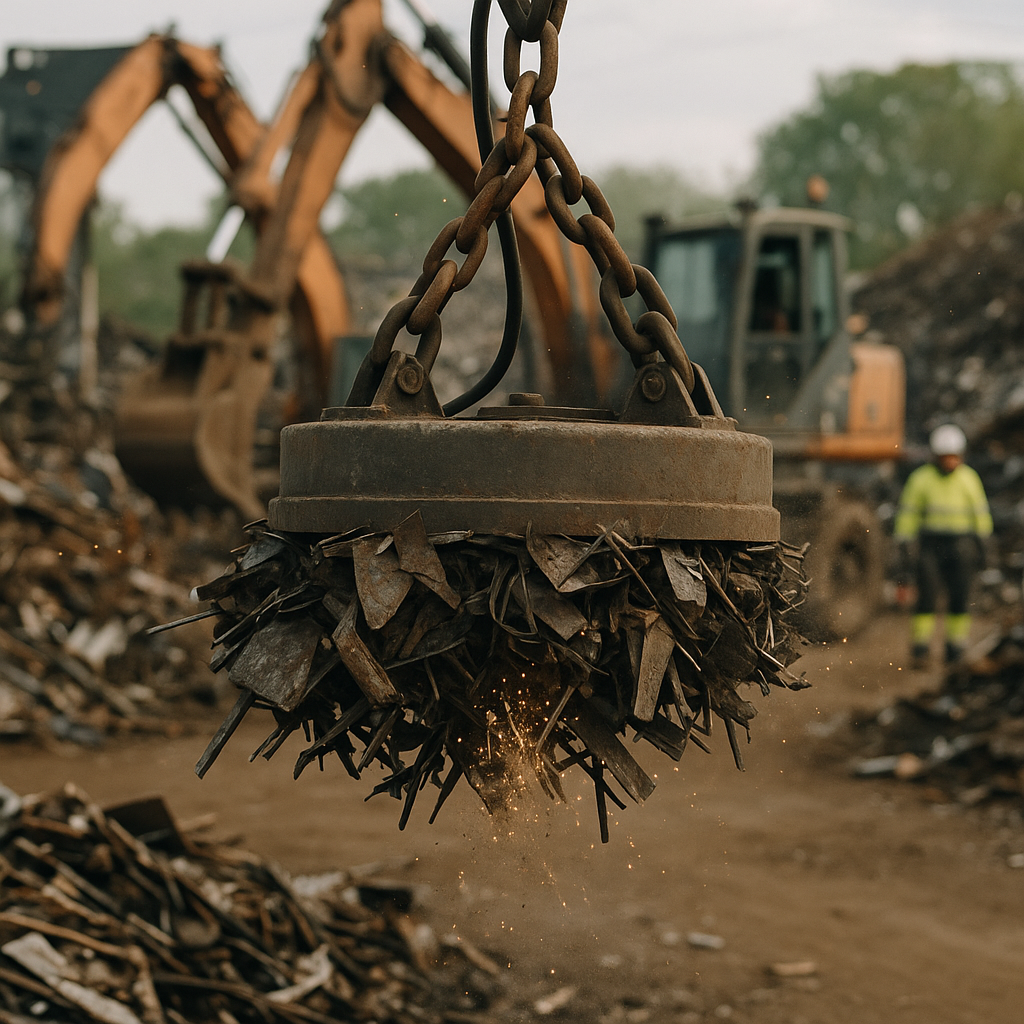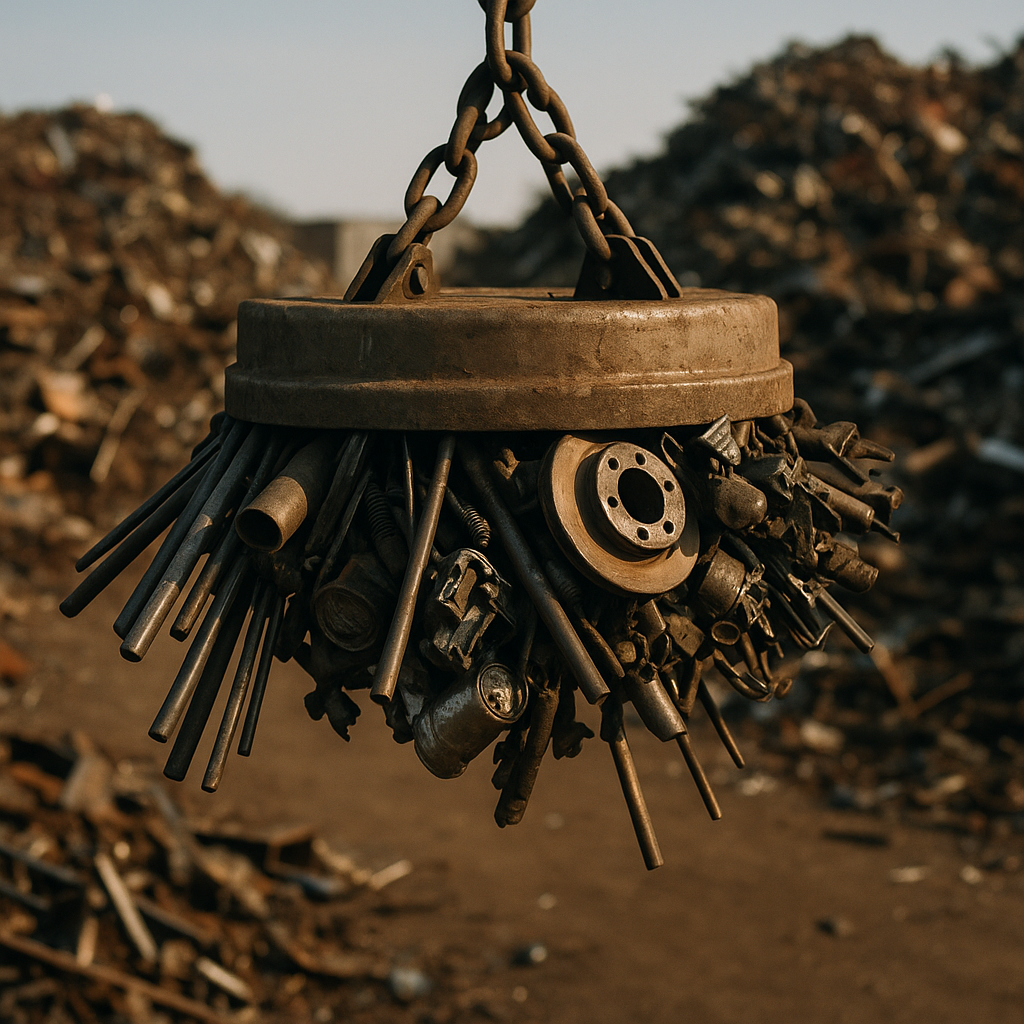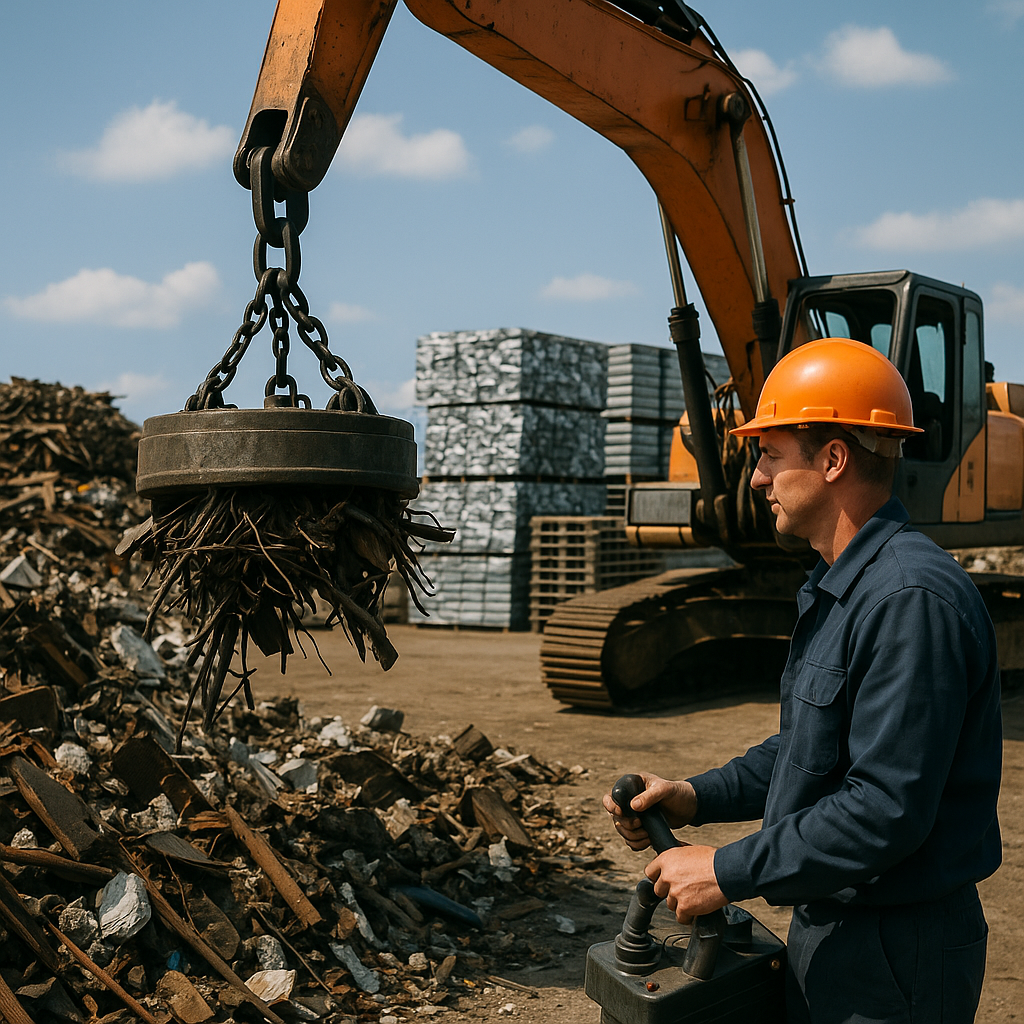5901 Botham Jean Blvd, Dallas, TX 75215
Scrap Metal Magnets: How Electromagnets Improve Recycling Efficiency
September 2, 2025Have you ever seen piles of twisted metal being moved through the air at a junkyard? The force behind this industrial ballet is a scrap metal magnet. These specialized electromagnets have a deep magnetic field designed for the demanding environment of scrapyards.
A scrap metal magnet generates a powerful magnetic field that attracts ferrous materials like iron and steel. Unlike regular magnets, these industrial tools can be switched on and off as needed, making them essential in modern recycling operations.
Typically mounted on cranes or excavators, scrap magnets efficiently sort, lift, and transport tons of metal debris in a single operation. Their design allows operators to handle irregular shapes and large volumes of scrap that would be impossible to move manually. These magnets have transformed the metal recycling industry by significantly increasing processing speed and efficiency.
How Do Scrap Metal Magnets Work?

Scrap metal magnets create a strong magnetic field when electricity is applied, allowing them to attract and lift ferrous metals like iron, steel, and nickel. The operation is straightforward yet powerful. The magnetic force generates enough pull to lift heavy loads of metal scrap, making these devices essential in recycling facilities and scrapyards.
The Science Behind Electromagnetic Lifting
Scrap magnets function based on a simple principle of electromagnetism: when electric current flows through a wire coil wrapped around an iron core, a magnetic field is created. This temporary field can be turned on and off with a switch.
Think of it like a light bulb. When you turn on a light switch, electricity flows through the circuit, and the bulb illuminates. Similarly, when power flows to the electromagnet, it instantly becomes magnetic. Cutting the power makes the magnetic field disappear just as quickly.
Step-by-Step Operation Process
The operation of scrap metal magnets follows a simple sequence. First, the operator positions the magnet above the pile of scrap metal. The magnet hangs from cranes, excavators, or other material handling equipment, suspended by chains or a rigid mount.
Next, the operator lowers the magnet into the pile. While in position, the operator activates the electromagnet by sending electric current through the coil. This creates a magnetic field that attracts and holds ferrous metals.
With the metal attached to the magnet, the operator lifts and moves the load to the desired location. Finally, cutting the electric current releases the metal by deactivating the magnetic field, allowing the scrap to drop.
Types of Metals That Respond to Magnets
Scrap magnets only work on ferrous metals—those containing iron. Common ferrous materials include mild steel, carbon steel, cast iron, and wrought iron. The presence of iron allows these metals to be attracted to the magnetic field.
Non-ferrous metals such as aluminum, copper, brass, and certain grades of stainless steel remain unaffected by the magnetic field. This selective attraction makes electromagnets valuable for sorting mixed metal scrap, allowing operators to separate ferrous materials from non-ferrous ones.
Power Sources and Control Systems
Most industrial electromagnets operate on direct current (DC) power rather than alternating current (AC). The power source might be a generator mounted on the equipment or connected to the facility’s electrical system.
Modern scrap magnets feature sophisticated control systems that allow operators to adjust the magnetic field strength for different applications. Some systems include safety features such as backup power supplies to maintain magnetism briefly during power interruptions, preventing dangerous drops.
The equipment also typically includes cooling systems to counteract the heat generated by the electrical resistance in the coils. Without cooling, this heat could damage insulation and reduce efficiency.
Advantages of Electromagnetic Control
The ability to quickly turn the magnetic force on and off gives electromagnets a significant advantage over permanent magnets. Operators can precisely control when to grab and release materials, making the sorting and handling process more efficient.
This control also enhances safety in scrapyard operations. Switching off the magnet only when the scrap is positioned correctly reduces the risk of falling debris. This process reduces the need for workers to manually handle sharp or heavy metal pieces, significantly decreasing workplace injuries.
What Materials Can Scrap Magnets Move?

Scrap magnets selectively attract and move only ferrous metals—those containing iron. This selectivity makes them invaluable tools in metal recycling operations. Magnets firmly grip materials like iron, steel, nickel, and cobalt, allowing for efficient separation from other materials.
When a scrap magnet passes over mixed metal waste, a clear division occurs. Ferrous metals are drawn upwards, clinging to the magnet’s surface, while non-ferrous metals remain unmoved. This magnetic property is the foundation of efficient metal sorting systems in recycling facilities worldwide.
Non-ferrous metals such as aluminum, copper, brass, and stainless steel do not respond to the magnetic field. Despite having significant recycling value—often higher than their ferrous counterparts—these metals require different sorting methods. This lack of magnetic response benefits recycling operations by enabling clean separation without additional processing steps.
The magnetic separation capability of scrap magnets enhances operational efficiency. Recycling facilities can process large volumes of mixed scrap quickly, with minimal manual intervention. The initial magnetic separation is a crucial step in the recycling workflow, creating distinct material streams for further processing.
This selective attraction reduces contamination in recycled material streams. When ferrous metals are cleanly separated from the waste stream, both ferrous and non-ferrous materials maintain higher purity levels. Higher purity correlates directly with higher market value for the recycled materials and less energy required for further refinement.
For recycling operations, understanding what a scrap magnet can and cannot move is essential for designing efficient processing systems. The clear physical difference between ferrous and non-ferrous materials allows for straightforward sorting technologies that form the backbone of modern metal recycling. This magnetic sorting capability transforms mixed metal waste into organized, valuable commodity streams ready for reintroduction into manufacturing.
What Are the Benefits of Using Scrap Metal Magnets?

Scrap metal magnets have transformed the recycling industry by enhancing the handling, sorting, and processing of ferrous materials. These powerful tools offer substantial advantages for scrapyards, recycling facilities, and demolition operations aiming to boost efficiency and profitability.
Increased Operational Efficiency
One of the most significant benefits of scrap metal magnets is their ability to handle large volumes of material quickly. Unlike manual methods, these magnets can lift and move substantial amounts of ferrous scrap in a single operation, significantly reducing processing time.
Scrap magnets streamline material flow throughout facilities by efficiently transferring metal from one processing stage to another. They are excellent at handling irregularly shaped scrap that would otherwise be difficult to move with conventional equipment, allowing for faster inventory turnover.
The speed these magnets offer is noteworthy. A North American scrap processing facility reported a 40% increase in daily throughput after implementing magnetic crane systems, enabling more material processing without workforce expansion.
Enhanced Workplace Safety
Safety improvements are another crucial advantage of scrap metal magnets. By eliminating the need for workers to manually handle heavy, sharp, or jagged metal pieces, these magnets significantly reduce injury risks.
Workers no longer need to interact physically with potentially dangerous scrap materials, preventing cuts, strains, and crushing injuries. Automating the lifting and moving of heavy metal also reduces fatigue-related accidents and repetitive strain injuries among employees.
The remote operation capability of many scrap magnets allows workers to maintain a safe distance from potentially hazardous materials and equipment, creating a safer overall work environment.
Cost-Effectiveness
The financial benefits of implementing scrap metal magnets are substantial. These systems reduce labor costs by automating tasks that would otherwise require multiple workers. One European scrapyard reported a 25% reduction in labor costs after adopting magnetic cranes for their operations.
Operational expenses decrease as scrap magnets improve sorting accuracy and material quality. By efficiently separating ferrous from non-ferrous metals, these magnets ensure proper categorization, maximizing recycling value and minimizing contamination.
Maintenance costs for other equipment also decrease. When scrap is handled more efficiently with magnets, there is less wear and tear on conveyors, shredders, and other processing machinery, extending their operational lifespan.
Environmental Benefits
Scrap metal magnets significantly contribute to environmental sustainability. They enhance the recycling process by improving sorting, ensuring more metal recovery rather than landfill disposal.
The precision of magnetic separation increases the purity of recycled materials, making them more valuable for manufacturing new products. This supports the circular economy by transforming waste into resources.
Energy conservation is another environmental advantage. Recycling metals using efficient magnetic sorting requires substantially less energy than mining and processing virgin materials. Recycling steel with efficient magnetic separation, for instance, uses about 75% less energy than producing steel from raw materials.
Versatility Across Industries
Scrap metal magnets prove valuable across multiple sectors. In scrapyards, they organize inventory, load trucks, and feed processing equipment efficiently. Construction and demolition operations use them to recover valuable metals from debris, turning waste into profit.
Manufacturing facilities employ these magnets to handle production scrap, while steel mills and foundries use them for loading furnaces and managing raw material inventory. The adaptability of scrap magnets to various environments and applications makes them essential tools across the metal recycling ecosystem.
From improving operational efficiency to enhancing safety, reducing costs, and supporting environmental sustainability, scrap metal magnets deliver comprehensive benefits that transform how businesses handle ferrous materials. Their ability to streamline operations while creating safer working conditions makes them an invaluable investment for any facility dealing with metal recycling or processing.
Conclusion: The Impact of Scrap Metal Magnets on Recycling

Scrap metal magnets have transformed the recycling industry by providing efficient, cost-effective solutions for material separation and handling. These powerful tools significantly enhance sustainability efforts by ensuring ferrous metals are properly sorted and recovered from mixed waste streams. The use of scrap magnets directly contributes to reduced landfill waste, lower energy consumption, and decreased CO2 emissions compared to mining and processing raw materials.
The environmental and economic benefits of scrap metal magnets extend across various industries, from scrapyards to demolition sites to automotive recycling facilities. If your business faces challenges with metal separation or aims to improve recycling efficiency, contact Okon Recycling at 214-717-4083 for tailored solutions to your recycling needs.
